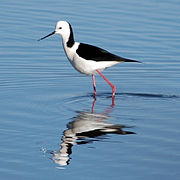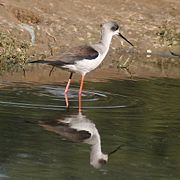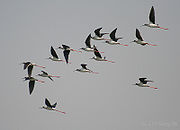
Black-winged Stilt
Background to the schools Wikipedia
SOS Children volunteers helped choose articles and made other curriculum material Do you want to know about sponsoring? See www.sponsorachild.org.uk
| Black-winged Stilt | |
|---|---|
 |
|
| Conservation status | |
|
Least Concern
|
|
| Scientific classification | |
| Kingdom: | Animalia |
| Phylum: | Chordata |
| Class: | Aves |
| Order: | Charadriiformes |
| Family: | Recurvirostridae |
| Genus: | Himantopus |
| Species: | H. himantopus |
| Binomial name | |
| Himantopus himantopus (Linnaeus, 1758) |
|
| Subspecies | |
|
|


The Black-winged Stilt, Himantopus himantopus, is a large wader in the avocet and stilt family, Recurvirostridae.
Adults are 33-36 cm long. They have long pink legs, a long thin black bill and are mainly white with a dark cap and a dark back.
The taxonomy of this bird is still somewhat contentious: some sources believe that there are as many as five distinct species; others consider some or all of these to be subspecies. The five forms are:
- nominate Himantopus himantopus himantopus, which occurs in most of the warmer parts of southern and southeastern Europe, southern Asia and north Africa.
- the Black-necked Stilt, which breeds from the US to northern South American has a dark head with a white spot over the eye (see Gallery). It is recorded as Himantopus mexicanus in the Sibley-Monroe checklist.
- the southern South America melanurus is larger than mexicanus and often has a white crown.
- the rare and endangered Hawaiian knudseni has more extensive black on its neck than the American forms.
- leucocephalus of southeastern Indonesia and Australia has a white head.
The breeding habitat of all forms is marshes, shallow lakes and ponds. The nest site is a bare spot on the ground near water. These birds often nest in small groups, sometimes with avocets.
Some populations are migratory and move to the ocean coasts in winter.
These birds pick up their food from sand or water. They mainly eat insects and crustaceans.
Threats and conservation
The Hawaiian Stilt or ae`o is endangered due to habitat loss. It is the only shorebird to breed in the Hawaiian Islands.
The Black-winged Stilt is one of the species to which the Agreement on the Conservation of African-Eurasian Migratory Waterbirds ( AEWA) applies.
Vagrancy
In Europe, the Black-winged Stilt is a regular spring overshoot vagrant north of its normal range, occasionally remaining to breed in northern European countries, for example in Britain in 1987.


